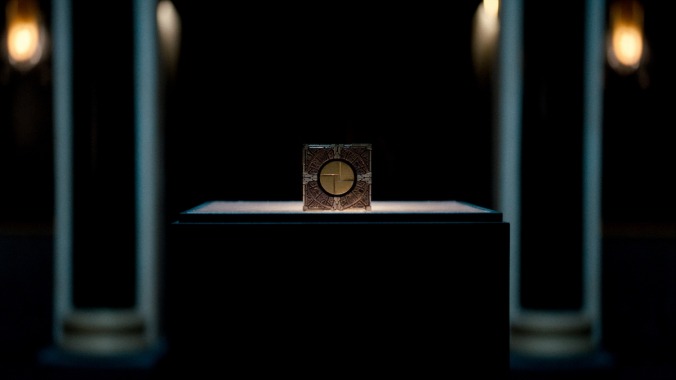What you need to know before watching the new Hellraiser movie
Whether you’re new to the Hellraiser-verse or just need a refresher, we’re here to prepare you for the latest installment in the franchise

Get ready to dim the lights and put the kids to bed early, because the new Hellraiser is finally out of development, er, hell. In some ways, it feels like its signature blend of sexually charged body horror never really went away. Since the original film premiered in 1987, the franchise has been steadily humming along, profitability be damned, adding new films and lore without ever having a hugely successful outing.
For those who aren’t keeping track (which, unless you’re a die-hard fan, is most of us), the new film brings the total number of sequels to an even 10. And then there are the comics, books, games, Halloween costumes, theme-park mazes, and fan films. And there’s even an HBO show in the works. Pinhead is one of the most recognizable horror villains of all time, right up there alongside the likes of Jason, Freddy, and Michael. But how much do you know about the mythology of the franchise? If you don’t have time to watch all 10 previous films before Hellraiser begins streaming on Hulu on Oct. 7—and we don’t recommend it—this handy primer should catch you up on all you need to know.
A brief(-ish) history of Hellraiser on film
In 1986, Clive Barker wrote a novella called The Hellbound Heart. Just one year later he would make his directorial debut on the film adaptation, titled Hellraiser. It wasn’t an instant hit, especially with critics, but the film found a devoted cult audience among horror fans, with some overlap from the fetish community. That was enough to merit a sequel, Hellbound: Hellraiser II, which came out the following year and picked up right where its predecessor left off.
Hellraiser III: Hell On Earth followed a few years later, in 1992, and had a character address Pinhead by name onscreen for the first time. The franchise’s theatrical era came to an end in 1996 with Hellraiser: Bloodline. It was a famously troubled production (receiving an Alan Smithee credit for the director, who wished to remain anonymous), but it was also notable for a few key reasons. For one, it traces the history of the infamous puzzle box at the center of the narrative through three time periods—the 18th century, present-day 1996, and the far future. For another, it features Adam Scott in a supporting role and some really unfortunate hairstyles. This was the last Hellraiser film released in theaters.
Like every long-running franchise, Hellraiser has had its period of diminishing returns. In the 2000s, there were four direct-to-DVD sequels produced, none of which added much to the lore. The seventh and eighth films, Hellraiser: Deader and Hellraiser: Hellworld, were actually produced back-to-back as a condition of filming in Romania. Doug Bradley, who had played Pinhead since the beginning, did not come back after the eighth film and was subsequently replaced with pale imitators. The ninth film, Hellraiser: Revelations, was made on a shoestring budget and screened only once in 2011, for the production crew who worked on it. It was reported at the time that Dimension Films only produced it to avoid losing the rights to the franchise. There was another attempt to revive it with a 10th film, Hellraiser: Revelations, but that one got lost in the executive shuffle following the departure of convicted sex offender Harvey Weinstein from Dimension’s parent company Miramax. Revelations was eventually released by Lionsgate on home media and on-demand in 2018.
Which brings us up to date and to the latest film, simply titled Hellraiser. Despite the title, it’s not a remake or a retelling of the story in The Hellbound Heart, though it does play with some of the same themes. They’ve also changed things up this time by reimagining Pinhead as a woman (played by Jaime Clayton) and focusing on a female protagonist (Odessa A’zion).
So who is this Pinhead guy anyway?
The character, whose official name is the Hell Priest, is the leader of a faction of demonic creatures called Cenobites. It was the original makeup team who first coined the nickname Pinhead behind the scenes of the first film, and it stuck (much to Clive Barker’s chagrin).
We learned in Hellraiser II that Pinhead was originally a British soldier fighting in World War I before he was transformed into the iconic Cenobite persona now inseparable from the franchise. In Hellraiser III, he was separated into his two sides, the human Elliott Spencer and the demon Hell Priest, for a while before being reunited and banished to hell once again. There are times when his humanity comes through, but mostly he just wants to bring people into his little corner of hell and torture them for eternity. In the comics and Barker’s other writings, it’s revealed that the title of Hell Priest is handed down, and there may have been others prior to Spencer taking over in the early 20th century.








![HBO teases new Euphoria, Larry David, and much more in 2026 sizzle reel [Updated]](https://img.pastemagazine.com/wp-content/avuploads/2025/12/12100344/MixCollage-12-Dec-2025-09-56-AM-9137.jpg)































